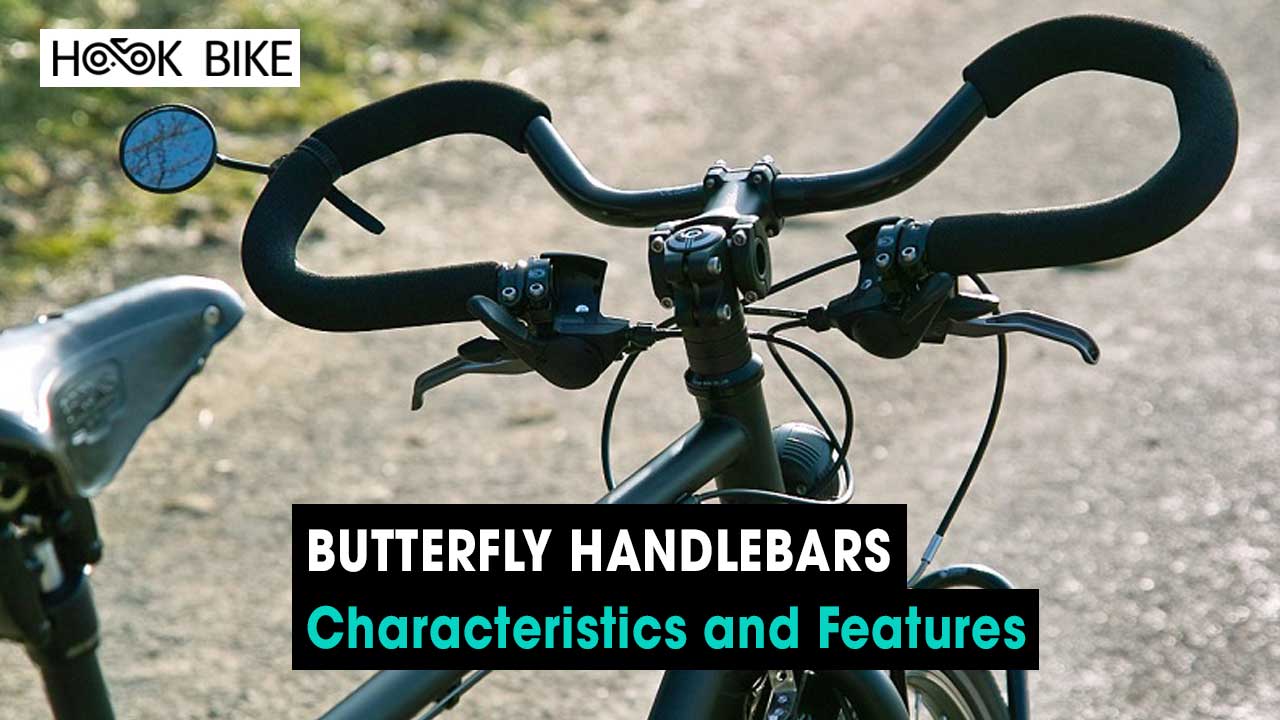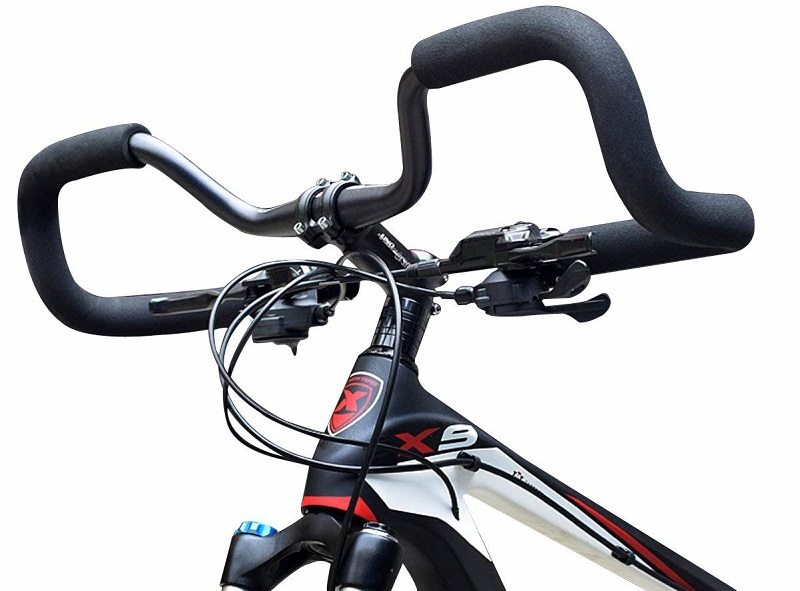Parts
Butterfly Handlebars Bike: Characteristics and Features
As avid cyclists and enthusiasts, we have witnessed the rise and fall of various trends and innovations in the biking industry. One such feature that has garnered significant attention is the butterfly handlebar. In this comprehensive guide, HookBike’s aim to delve into the unique characteristics and features of Butterfly Handlebars and their impact on biking experiences.
History and Evolution of Butterfly Handlebars
Butterfly handlebars, often referred to as “touring” or “trekking” handlebars, are primarily designed for long-distance cycling comfort and versatility. Here’s a brief history and evolution of butterfly handlebars:
Origins
The exact origin of the butterfly handlebar is a bit murky, but it’s widely accepted that it emerged during the 20th century, especially with the rise of long-distance touring in Europe. As touring cyclists sought more hand positions and greater comfort over extended rides, the need for a versatile handlebar design became evident.

Design and Features
The distinctive design of the butterfly handlebar is its looped, almost figure-eight shape. This design offers multiple hand positions – one can grip the bars near the stem for an upright position, on the sides for a more aerodynamic posture, or on the outermost section for a wide grip, which is particularly useful when climbing. The variety of hand positions helps reduce fatigue on long rides and provides relief from sustained hand and wrist positions.
Popularity in Touring
The 1980s and 1990s saw a significant rise in the popularity of long-distance bicycle touring. This was especially true in Europe, where the diverse landscapes and bike-friendly infrastructure made touring a preferred choice for many cyclists. As the demands of these touring enthusiasts grew, butterfly handlebars gained traction due to their ergonomic benefits and flexibility.
Modern Evolution
With the advent of new materials and manufacturing techniques, modern butterfly bars have become lighter and more durable. They can be made from aluminum, carbon fiber, or steel. Additionally, there’s been a trend toward integrating ergonomic grips and bar ends for added comfort. Accessories like mirrors, bells, and lights can easily be added to butterfly bars, further enhancing their appeal for touring.
Critiques and Limitations
While butterfly handlebars offer a myriad of hand positions, they can be bulkier and slightly heavier than more streamlined handlebar designs. Also, their wide stance can sometimes be a disadvantage in tight traffic conditions.
Future Outlook
While the fundamental design of the butterfly handlebar remains relatively unchanged, it’s likely that future iterations will focus on materials, integration of technology (like built-in lighting), and more ergonomic designs
See more: types of bicycle handlebars

Butterfly handlebars emerged as a response to the demands of long-distance touring cyclists and have evolved over the years to incorporate advances in materials and design. They continue to be a popular choice for those prioritizing comfort and multiple hand positions on their rides.
Main Characteristics of Butterfly Handlebars
Butterfly handlebars, also known as trekking or touring handlebars, are specifically designed for comfort and versatility, especially during long rides. Here are the main characteristics of butterfly handlebars:
- Ergonomic Design: Butterfly handlebars are praised for their ergonomic structure. This design reduces strain on the wrists and shoulders, ensuring that riders can cover longer distances without discomfort.
- Multiple Hand Positions: One of the standout features of butterfly handlebars is the variety of hand positions they offer. This adaptability is especially beneficial for long rides, as changing hand positions can alleviate numbness and fatigue.
- Increased Control: Due to their wider grip span, butterfly handlebars provide increased control, especially during downhill rides and when navigating tricky terrains.
- Easy Access to Gear Shifters and Brakes: Butterfly handlebars are designed with both functionality and safety in mind. With this design, gear shifters and brakes are easily accessible, allowing for quick reactions during rides.
Butterfly handlebars are characterized by their unique looped design, offering multiple hand positions and an emphasis on comfort and versatility. They are a favorite among long-distance and touring cyclists for these reasons.

Features and Benefits of Using Butterfly Handlebars
Butterfly handlebars, cherished by touring cyclists, have distinct features that offer a range of benefits to their users. Let’s break down these features and the corresponding advantages:
Features of Butterfly Handlebars
- Looped Design: One of the most noticeable features of butterfly handlebars is their rounded, almost figure-eight shape, which is significantly different from traditional flat or drop bars.
- Wider Width: They are often broader than most other handlebars, providing more space for the rider’s hands and for mounting accessories.
- Versatile Hand Positions: The handlebar design allows for several gripping areas, each serving a different riding posture.
- Sturdy Construction: Typically made from durable materials like aluminum, steel, or sometimes carbon fiber.
- Ergonomic Options: Many come equipped with or have the option to add ergonomic grips to enhance comfort.
Benefits of Using Butterfly Handlebars
- Reduced Fatigue: The ability to change hand positions frequently reduces the risk of numbness and fatigue in the hands, wrists, and arms during long rides.
- Upright Riding Position: The design of the handlebars, especially when hands are placed near the stem, promotes an upright riding position. This can reduce strain on the back and neck, making it comfortable for extended periods of riding.
- Accessory Space: The wide design provides ample space to mount various accessories like cycle computers, lights, bells, and mirrors without crowding.
- Stability: The wide grip option offered by the outermost section of the handlebars can provide added stability, especially when climbing or navigating tricky terrains.
- Adaptability: Whether facing headwinds, climbing, or just cruising, the multiple hand positions allow riders to adapt to different situations and terrains effortlessly.
- Ergonomic Comfort: For those with ergonomic grips, the added contouring can provide better hand comfort, especially on bumpy roads or longer rides.
- Versatility in Riding Styles: Whether you’re on city roads, country paths, or rugged terrains, the adaptability of butterfly handlebars makes them suitable for a variety of riding styles and conditions.
- Durability: Given their primary use for long-distance touring, these handlebars are built to withstand the demands of heavy loads and diverse terrains, ensuring longevity and robust performance.
The butterfly handlebars, with their distinctive features, provide numerous benefits, mainly centered around comfort and adaptability, making them an excellent choice for long-distance cyclists and tourers.
See more: Cruiser Handlebars

Comparing Butterfly Handlebars to Other Handlebar Types
When selecting handlebars for a bike, it’s essential to understand how each type fits the intended riding style and comfort preferences. Let’s compare butterfly handlebars with some of the other popular handlebar types:
Butterfly Handlebars
Primary Use: Long-distance touring.
Features: Looped, figure-eight shape offering multiple hand positions.
Advantages:
- Versatility in hand positions reduces hand and wrist fatigue.
- Ample space for mounting accessories.
- Promotes an upright riding posture, reducing back and neck strain.
Disadvantages:
- Less aerodynamic due to its wide design and the upright posture of the rider.
- Might be bulkier than other handlebar types.
Drop Handlebars
Primary Use: Road cycling, racing.
Features: Curved shape that “drops” down, allowing the rider to grip either the top flat section or the lower curved section.
Advantages:
- Aerodynamic posture when gripping the drops, ideal for speed.
- Multiple hand positions, including on the tops, hoods, and drops.
- Often lighter than other handlebar types.
Disadvantages:
- The aggressive, forward-leaning posture might be uncomfortable for some riders over long distances.
- Less space for accessories.
Flat Handlebars
Primary Use: Mountain biking, commuting.
Features: Straight bar without significant rise or drop.
Advantages:
- Provides a direct and responsive control, ideal for technical terrains.
- Promotes an upright position, suitable for city riding and visibility.
- Simplicity and compatibility with many brake and gear systems.
Disadvantages:
- Limited hand positions can lead to fatigue on longer rides.
- Not very aerodynamic.
Riser Handlebars
Primary Use: Mountain biking, recreational riding.
Features: Similar to flat bars but with a rise, elevating the grips area higher than the stem.
Advantages:
- More upright posture than flat bars, offering better visibility and comfort.
- The rise can provide better control on downhill sections.
Disadvantages:
- Like flat bars, limited hand positions.
- Can be heavier than flat bars.
Bullhorn Handlebars
Primary Use: Urban cycling, track cycling.
Features: Straight bar that curves forward and then upwards at the ends, resembling bull horns.
Advantages:
- Offers two main hand positions: straight grip and the horn grip.
- Allows riders to lean forward and get more power, especially when accelerating or climbing.
Disadvantages:
- Limited hand positions compared to butterfly or drop bars.
- Might not be as comfortable for very long rides.
The ideal handlebar type largely depends on the rider’s priorities, whether it’s speed, maneuverability, comfort over long distances, or a mix of these factors. Butterfly handlebars stand out for their superior comfort during extended rides, but each handlebar type has its unique advantages catering to specific cycling needs.
See more: Drop Handlebars

How much does a Butterfly Handlebars Bike cost?
The cost of butterfly handlebars or a bike equipped with butterfly handlebars can vary widely based on several factors:
- Brand & Quality: Recognized brands or higher-end handlebars are generally more expensive due to the quality of materials used and the reputation of the brand.
- Material: Butterfly handlebars made of carbon fiber tend to be pricier than those made from aluminum or steel.
- Included Features: Some handlebars come with additional features like ergonomic grips or integrated mounts, which can raise the price.
- Type of Bike: A complete bike equipped with butterfly handlebars will have its price influenced by factors like the frame material, components, brand, and type (e.g., touring bike vs. city bike).
Rough Price Estimates
Butterfly Handlebars Alone
- Basic aluminum models can start as low as $20-$40.
- Mid-range options might be in the $40-$80 bracket.
- High-end models, especially those made of carbon fiber, can exceed $100.
Complete Bikes with Butterfly Handlebars
- Budget touring or city bikes might start around $500-$800.
- Mid-range touring bikes can range from $800 to $2,000.
- High-end touring bikes, equipped with top-tier components and possibly butterfly handlebars, can go well beyond $2,000, with some premium models exceeding $4,000 or more.
It’s essential to remember that prices can change over time due to inflation, changes in manufacturing costs, brand strategies, and regional differences. For the most accurate and up-to-date pricing, it’s a good idea to check with local bike shops, online retailers, or manufacturers’ websites.
Conclusion
Butterfly handlebars stand out in the world of cycling due to their unique blend of ergonomics, functionality, and aesthetic appeal. Designed with the modern cyclist in mind, they offer numerous benefits, from multiple hand positions to enhanced control. Whether you’re a seasoned professional or someone who enjoys the occasional ride, butterfly handlebars might just be the perfect addition to elevate your biking experience.

